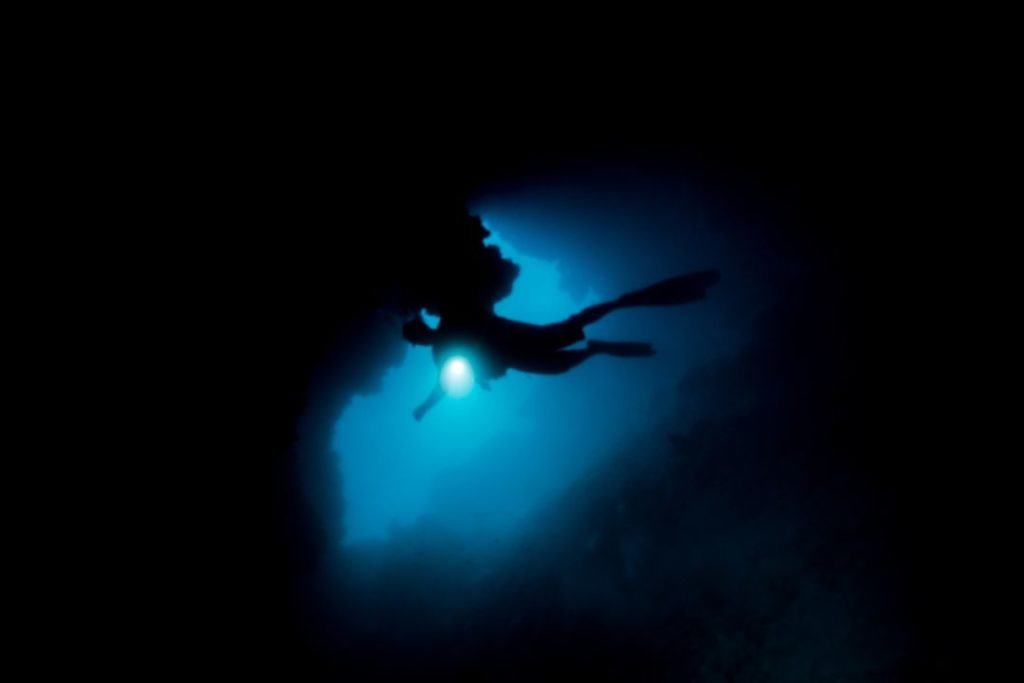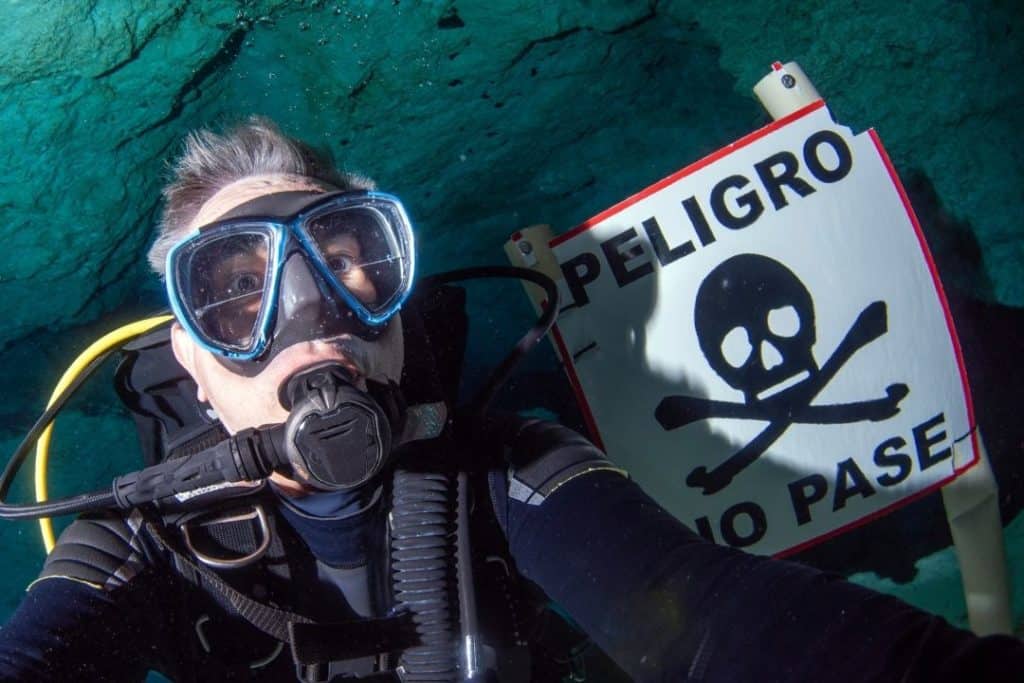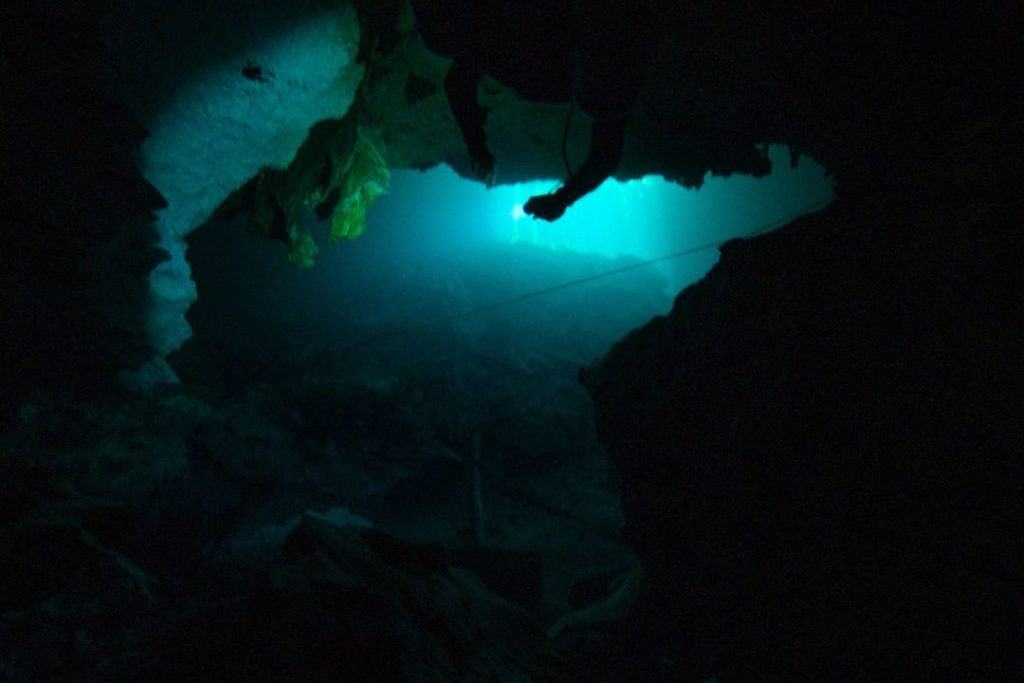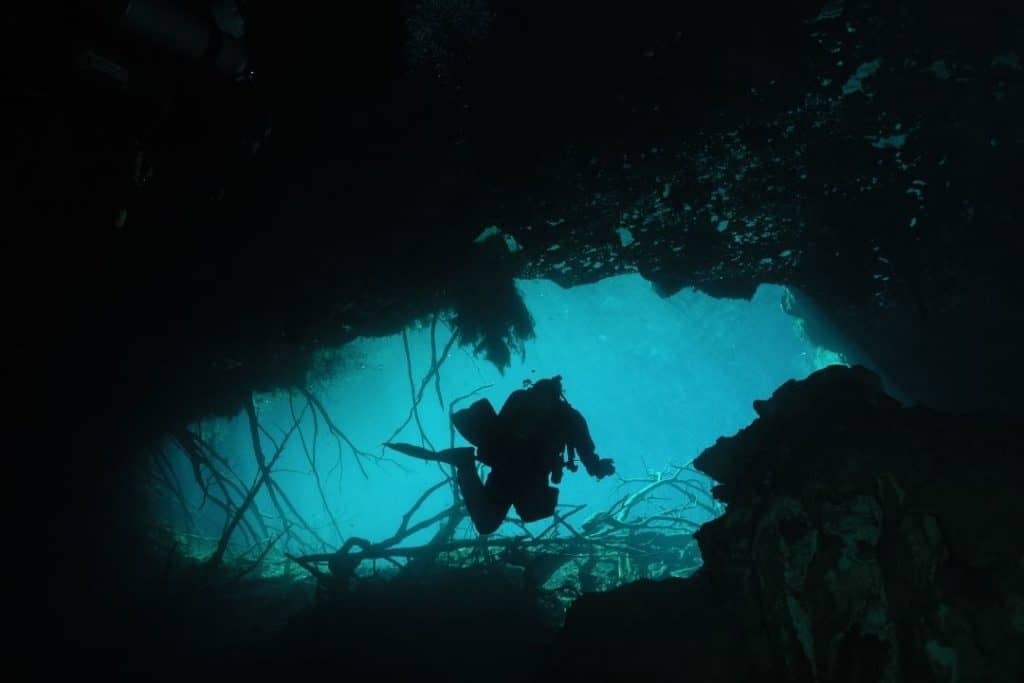Why cave diving is dangerous is a frequently asked question. Cave diving has been called the most wondrous and the most dangerous underwater activity.
Still, there are thousands for divers worldwide who have taken up this highly specialized aspect of scuba diving.
You will find both scientific divers, who are diving to expand man’s knowledge of a unique ecosystem and divers looking to their personal knowledge and challenges.
You could list hundreds of reasons why cave diving is dangerous. A summary explanation may be that cave diving is done in an overhead environment with limited visibility.
These factors can limit your options to react to simple concerns causing a cascading effect that can lead to a fatality.
The article on what is cave diving gave a good overview of cave diving.
In this article we will focus more on the dangers that a caver may face and why it is critical to be properly trained before entering a cave.
Visibility Issues and Cave Diving Dangers

Dangers lurk in the darkness. I am not referring to the monsters hiding under every child’s bed nor to people who are afraid of the dark.
When we are in a cave beyond the ambient light zone, our only source of light is that which we bring with us. We do not know what awaits, out of the beam of light.
Modern life means most people do not frequently experience total darkness. Light pollution means a city is never totally dark.
Even at night our homes will likely have some source of light even if it is very dim. It may be from a digital clock, or a charging cell phone.
We can see where a window is as light from outside will frame it. Total darkness is not a common occurrence.
When you get away from city lights and venture out on a tree lines rural road on a cloudy night, you may experience a situation that equals diving in a cave or wreck.
All you can see is what is in the beam of your lights. Look to your left or right and nothing is there beyond your car.
Afraid of the dark or not, you will wonder what is out there that may affect your driving.
Will a deer jump out in front of you?
In a cave you may have a wall next to you, making the space seem closed in. Your whole world is reduced to the space illuminated by your diving light.

Another key visibility issue in cave and wreck diving, deals with the quality of the water. When the water is crystal clear, you are able to see great distances.
When there are particles in the water, your light beam will be diffracted, limiting your light and making it harder to see.
Two of the more important skills you need as a caver, are buoyancy control and fin control.
Unless you have mastered these skills, you are at risk of disturbing silt that has accumulated within a cave.
It may take only a few seconds of lost control or inattentiveness to hit the bottom and raise a cloud of silt.
A cloud so thick that you can not see beyond it, even with your lights. There are often no currents in a cave so it may take a long time for a silt out condition to dissipate.
Navigation Issues AKA Getting Lost

One set of skills learned in cave diving, cenote diving experiences and wreck diving classes is the use of reels and guidelines.
Sort of like dropping bread crumbs to find your way back home. Some caves will have guidelines permanently installed.
Cavers will just follow the line in and then out again.
The guideline will have markers to indicate which directions to go. If there is no existing guideline, then a group of divers will use a line and reel to lay their own.
The lead diver will secure the line and let out more line as they go deeper into the cave system.
Periodically the line will be tied off, reducing the risk of it being broken if pulled on.
The procedures will have the following divers keep in contact with the line. The reason for the contact is if there is a silt out condition, the divers know the way out still.
When exiting, the last diver will be responsible for recovering the line as they move closer to where they entered.
Without a line, it would be easy to get lost. The view exiting will be different than the one entering.
Also, you would have to remember all the turns you made and which side branches you did not use.
Diving a ship wreck, all of your turns will be at 90 degrees. Nature is more creative. A cave may wander and the turns may be subtle.
Also, you may be gradually changing depths which can alter your perception of where you are.
Cave Divers are At Risk For Entanglement and Entrapment

Another reason why cave diving can be dangerous is the risk of entanglement and entrapment.
Of the two, entrapment is the larger risk in a cave system.
Fishing lines, cables and kelp are the most common items divers become entangled with, and they are rare in caves.
On the other hand, caves are not uniform and there may be areas where the passage becomes small and you could become stuck.
It may even be something as simple as your tank valve snagging something. However, the area may be so confined that your dive buddy can not easily get your free.
Why Do Cave Diver Die?

Statistics for cave diving are not centralized, so it is difficult to assign a number of deaths per a certain number of dives.
It is accepted that cave diving is the highest risk in scuba diving. You may imagine that the reason cavers die is they get lost and run out of air.
The real answer may be more complicated then that. Navigation and air consumption are critical task for cave diving.
However, in most fatal cases, it was a simple problem improperly handled and complicated by the diving environment.
Not being able to ascend directly to the surface or limited lights could cause the response to the problem to be ineffective.
Consider what may happen when a buddy team is not in contact with a guideline and one of the divers causes a silt out.
Neither diver can see the other and have no way to find their way out. They start breathing faster and use their air supply at an alarming rate.
A common summary of cave diving accident say that the divers encountered situations beyond their level of training and skills.
Is Cave Diving Dangerous, It is About Risk Management.
Cave diving is not for everyone. It is the most dangerous form of scuba diving, still it can be very rewarding.
Like anything we do in life, it is about risk management. If you receive proper training and have developed your skills it may be an acceptable risk that you are willing to take.
Just like you take a risk each day driving to work.
If you are a caver, please share some of your experiences!
